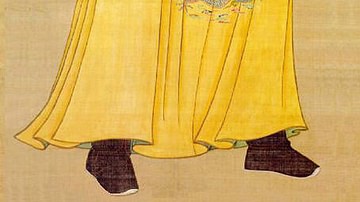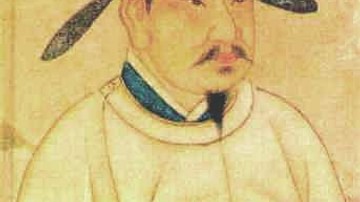Subjects
States & Cultures (113) Religion & Mythology (106) Art & Architecture (103) Individual People (81) Daily Life (59) Warfare & Battles (46) Places (40) Philosophy & Science (28) Time Period (15) Natural Phenomenon (4)
Regions
East Asia (135) Mediterranean (105) Middle East (53) Northern Europe (49) Africa (39) Americas (25) South Asia (18) Central Asia (6) Oceania (2)
The Tang Dynasty (618-907 CE) was one of the greatest in Imperial Chinese history. It was a golden age of reform and cultural advancement which lay the foundation for policies which are still observed in China today. The second emperor, Taizong…

Taizong (birth name, Li-Shimin, l. 598-649 CE, r. 626-649 CE) was the second emperor of the Tang Dynasty and is considered one of the greatest rulers in Chinese history for his reforms of the government and the laws, his religious tolerance…

Xuanzong (birth name, Li Longji, l. 685-762 CE, r. 712-756 CE) was the 7th emperor of the Tang Dynasty of China, whose domestic and foreign policies established the Tang Dynasty as the Golden Age in Chinese history. Many of the most important…

Emperor Gaozu (also Kao-tsu, formerly Li Yuan, r. 618-626 CE) was a Sui military commander who led a rebellion against his former masters, seized control of the state, and founded the Tang Dynasty (618-906 CE). Overshadowed in the ancient…

The art of the Tang Dynasty (618-907 CE) began to explore new possibilities in materials and styles with landscape painting and ceramics, in particular, coming to the fore. New techniques, a wider range of colours and an increase in connoisseurship…
Wuzong of Tang (also Wu-Tsung, formerly Li Yan) reigned as emperor of China from 840 to 846 CE. He is best remembered today for his persecution of Buddhists, the worst such attack in all of China”s history, and his early death by insanity…
Chinese literature is among the most imaginative and interesting in the world. The precision of the language results in perfectly realized images whether in poetry or prose and, as with all great literature, the themes are timeless. The Chinese…
Empress Wu Zetian (Empress Consort Wu, Wu Hou, Wu Mei Niang, Mei-Niang, and Wu Zhao, l. 624-705 CE, r. 690-704 CE) was the only female emperor of Imperial China. She reigned during the Tang Dynasty (618-907 CE) and was one of the most effective…
The emperors of ancient China had tremendous power and responsibility. Called the “Son of Heaven”, he (and once she) was given a divine right to rule over all people but was expected to promote their best interest and not his own. An absolute…
Taoism (also known as Daoism) is a Chinese philosophy attributed to Lao Tzu (c. 500 BCE) which developed from the folk religion of the people primarily in the rural areas of China and became the official religion of the country under the…
Numerous educational institutions recommend us, including Oxford University and University of Missouri.Our publication has been reviewed for educational use by Common Sense Education, Internet Scout, Merlot II, OER Commons and School Library Journal.Please note that some of these recommendations are listed under our old name, Ancient History Encyclopedia.
Đang xem: Trực tiếp bóng đá miễn phí
Our MissionOur mission is to engage people with cultural heritage and to improve history education worldwide.
Xem thêm: 24 Mã De Thi Thpt Quốc Gia 2020 Môn Sử, Đề Thi Lịch Sử Tốt Nghiệp Thpt Quốc Gia 2020
About •Contact •Privacy Policy •Partners •Sponsors •Donations •Newsletter •Settings
World History Publishing is a non-profit company registered in the United Kingdom.World History Foundation is a non-profit organization registered in Canada.
Xem thêm: Học Phí Trường Đại Học Bách Khoa Hà Nội, Trường Đại Học Bách Khoa Hà Nội
Some Rights Reserved (2009-2022) under Creative Commons Attribution-NonCommercial-ShareAlike license unless otherwise noted.